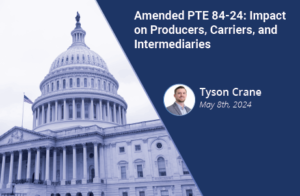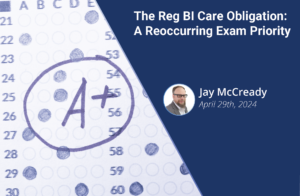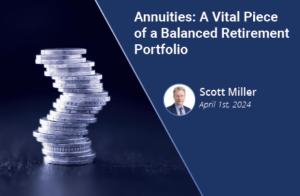January 24th, 2024 | Trevor Morgan, Principal Product Manager, CapitalROCK
On October 31st, the Department of Labor released the proposed Retirement Security Rule, redefining the qualifications for fiduciary advice. With the new definition, the financial services industry is forced to reconsider a question that has repeatedly resurfaced over the last three decades – Is plan participant “education” a viable route to avoid fiduciary status when performing a rollover?
In this article, we’ll cover the difference between “advice” and “education” as it stands under current regulation. We’ll also look at the newly proposed Retirement Security Rule, and its potential impact on the viability of each approach. Whether you’re an independent rep, an investment advisor representative, or a compliance officer at an enterprise broker-dealer, it’s critical to understand how these definitions impact you. A mischaracterization of the services you offer could mean fines, suspensions, and litigation.
Advice
The original ERISA regulation of 1974[1] defines when advice provided to a retirement plan participant will be considered “fiduciary”, using a five-part test. The following definition has stood for 50 years, despite failed attempts to modify it in both 2010 and 2016:
-
- Rendering Advice: The advisor provides investment or retirement-related advice to the plan, plan fiduciary, plan participant, or IRA owner for a fee or other compensation, whether direct or indirect.
-
- Regular Basis: The advice must be provided on a regular basis, meaning it is not an occasional or one-time occurrence. Regular basis implies a systematic pattern of providing advice.
-
- Individualized Advice: The advice provided must be individualized or tailored to the specific needs of the recipient. It takes into account the particular investment needs, objectives, financial situation, and other relevant factors of the individual.
-
- Primary Basis for Decision-Making: The advice must serve as the primary basis for the recipient’s decision-making with regard to the management of the plan or IRA assets. In other words, the advice should have a significant impact on the recipient’s decision-making process.
-
- Management or Control: The fifth element involves the advisor having control or authority over the management of the plan or IRA assets. Alternatively, the advisor must have discretionary authority or control over the administration of the plan.
If all five of these conditions are met, a financial professional providing recommendations to an ERISA plan participant is considered a fiduciary. Should this barrier be breached, the rep or advisor is then subject to the full weight of that designation. They are held to the highest standards of conduct (including the duties of loyalty and prudence) and must act solely for the benefit of the plan participant. They must document their decision-making process. They expose themselves to personal liability for breaches of that duty. Perhaps most impactfully, they are prevented from engaging in transactions that have the potential to harm the plan or its participants (“prohibited transactions”). A broker-dealer or investment advisor would no longer be able to receive compensation for recommendations to roll assets out of a plan to an IRA, as there is an implicit conflict of interest.
There is, however, a path forward. The Department of Labor understands that restricting compensation completely for these “prohibited transactions” would do as much harm as it would prevent. With no financial incentive to provide advice, and a slew of potential risks for doing so, financial professionals would likely abandon any aspect of their business that touches ERISA assets. Main Street investors would have nowhere to turn for help. To prevent this scenario, the DOL offers certain Prohibited Transaction Exemptions (PTEs) that allow financial professionals to continue to receive compensation for these potentially conflicted transactions despite retaining a fiduciary status. These are, essentially, prescribed paths an advisor can follow to receive compensation while simultaneously evidencing their compliance with the best interest spirit of the fiduciary standard. Examples of DOL class exemptions include PTE 2020-02 (which we’ll dive into later), PTE 84-24, and several others that fall outside the scope of this article.
Many financial institutions, seeking to avoid the task of institutionalizing compliance with a PTE, have sought ways to avoid the fiduciary designation completely.
Education
In June of 1996, the Department of Labor released Interpretive Bulletin 96-1, with the stated purpose of “[assisting] plan sponsors, service providers, participants, and beneficiaries in determining when activities designed to educate and assist participants…. will not cause persons engaged in such activities to become fiduciaries with respect to a plan…”[2] In other words, it defines a carveout for financial professionals that allows them to educate participants without stepping into the fiduciary bear trap.
The DOL offers several examples of investment education that could be offered without triggering a fiduciary obligation:
-
- Plan Feature Information: Providing general information about the ERISA plan itself, including fees, investment options, benefit types, and other plan-specific characteristics.
-
- General Investment Information: Offering insights on general and universally applicable financial concepts (ex. dollar-cost averaging, inflation, risk and returns, diversification)
-
- Asset Allocation Models: Furnishing models that illustrate hypothetical scenarios with differing risk and return characteristics. The intent is, again, to provide general information on the importance of diversification.
-
- Interactive Investment Materials: These could include such examples as worksheets or software applications the participant can engage with directly. These materials could help the participant assess their own financial priorities (risk tolerance, investment goals), or they could provide theoretical representations of retirement income as impacted by asset allocations.
When providing any of the above, it is critical that no recommendation is made. In addition, the burden rests on the financial professional to ensure that the educational materials provided do not contain any implicit bias. Any assumptions in the models or interactive materials must be disclosed. If any specific investment products or strategies are mentioned, an accompanying statement must be supplied that discloses the existence of comparable alternatives along with where to learn more about them.
Choosing a Path
Given these definitions, the rep/advisor and their associated financial institution must choose a path forward. Do they embrace the fiduciary designation and leverage a PTE, or do they circumvent the battle and resort to pure education?
At first glance, the education approach appears to be the simpler of the two. When successfully executed, the financial professional and their associated financial institution shift the responsibility for investment decisions to the client. There is no need to document the rationale for the recommendation that was never made. There is no best interest requirement when there is no action that requires disinterested advice. Most relevantly, there is no prohibited transaction—no barrier between the advisor and compensation.
This mirage, however, dissipates quickly under closer inspection. Serious risks exist for both the representative and their financial institution. For the representative, the line between education and advice can become impossibly thin given the nature of the client/professional relationship. Questions such as the following are inevitable:
-
- “What would you do in my situation?”
-
- “How should I proceed?”
-
- “How would you allocate my portfolio if I gave you discretionary authority?”
How does a rep handle this situation? How do they consistently deflect these questions, especially given the financial incentive that exists to prompt the client in the direction of a paid service?
To further complicate the matter, the DOL has provided dangerously subjective guidance on when a relationship has crossed the line into fiduciary territory. In its April 2021 FAQ, the DOL declared that it “intends to consider the reasonable understandings of the parties based on the totality of the circumstances. Firms and investment professionals cannot use written disclaimers to undermine reasonable investor understandings.”[3] In other words, a financial professional’s actions only constitute half of the equation—the client’s interpretation of the interaction matters.
The rep isn’t the only entity in danger of bearing the fiduciary burden. The financial professional’s associated financial institution serves as a co-fiduciary in the relationship and shares the burden of ensuring its advisors fulfill their fiduciary duty. For that firm, all the risks applicable to an individual rep are now multiplied across the entire organization. If you are a compliance professional at those financial institutions, you are responsible for setting up monitoring/surveillance systems and trainings to ensure that ALL associated representatives properly navigate these complicated conversations.
Should an infraction occur, the education approach offers no approved self-correction procedure, unlike several PTEs. The consequences for engaging in a prohibited transaction without an exemption are severe. One or more of the following may apply:
-
- Disgorgement of profits
-
- Right of rescission
-
- Excise tax
-
- Civil penalties
These prohibited transactions may also constitute securities law violations. Should a representative step inadvertently into the realm of recommendations, they could find themselves running afoul of SEC Reg BI or the Advisers Act. These carry their own hefty price tag. In July of 2021, the Securities and Exchange Commission announced a $97 Million enforcement action against a subsidiary of TIAA to “settle charges of inaccurate and misleading statements and a failure to adequately disclose conflicts of interest to thousands of participants in TIAA record-kept employer-sponsored retirement plans (ESPs).” [4]
The advice route carries its own challenges. The fiduciary must select a Prohibited Transaction Exemption applicable to their business and follow the prescribed standard. The most applicable PTE currently is and will continue to be PTE 2020-02[5]. There are four main requirements for fulfillment:
-
- Compliance with the Impartial Conduct Standards: The advisor must act in the best interest of the investor, only charge reasonable fees, and make no materially misleading statements.
-
- Disclosure: They must acknowledge their fiduciary status, deliver the specific reasons for the rollover to the client, and describe the service offered and material conflicts of interest.
-
- Policies and Procedures: The firm must maintain written policies and procedures to ensure compliance with the previous two items.
-
- Retrospective Review: The financial institution must conduct an annual review of advisor activity to detect violations of its policies and procedures.
While these requirements appear stringent at first, there are several benefits to this approach. First, the firm can maintain consistent policies and procedures for all transactions and interactions under the assumption of a fiduciary obligation. Second, should an infraction occur, the PTE offers the firm an option to self-correct, mitigating some of the damages. Finally, as any investor knows, risk is a relevant consideration in any investment. A firm following this approach can rest easy knowing broad swaths of its past dealings won’t suddenly be implicated by a subjective interpretation of their client interactions.
The advice path not only yields significant benefits but is also not as cumbersome as it may first appear. The DOL intentionally aligned many of the requirements with existing regulations. The Impartial Conduct Standards are derived from SEC’s Reg BI, for which firms should have existing policies and procedures. The Retrospective Review is similar to existing FINRA requirements for periodic supervision reports. Finally, software applications such as RightBRIDGE® have been developed to systematize and automate rollover suitability review.
Looking Forward
The debate over education vs advice was again brought to the forefront with the release of the proposed Retirement Security Rule in 2023. With the amendment to the fiduciary definition came modifications to existing class exemptions that effectively route most ERISA prohibited transactions through PTE 2020-02. The new regulation made it clear that investment education as defined by Interpretive Bulletin 96-1 was still permissible as an exception and would not trigger a fiduciary duty. Some have interpreted this to mean the education approach will remain a viable path moving forward.
Others have pointed to sections of the text that conflict with this interpretation. For example, in a testimony provided by SIFMA at the DOL hearings on the proposed Retirement Security Rule, Lisa Bleier noted that “The proposal also seems to preclude any education in the rollover area: the Department will simply deem any conversation about a rollover as a fiduciary conversation.”[6] It’s also telling that the DOL repeatedly emphasized the spirit of the regulation—if the retirement investor has a reasonable expectation for fiduciary advice, then the DOL considers it fiduciary advice.
Regardless, the landscape is still developing, and the industry will need to await further clarity in the form of the final rule, supplementary FAQs, and the certain litigation that will ensue should the rule be implemented. Until that point, it’s up to individual firms to interpret current regulations, determine their appetite for risk, and apply them as they see fit in their own practice. One thing is certain—the Department of Labor has picked this battle, and the consequences for noncompliance are significant.
Note: Much of the information for this topic was delivered by the Wagner Law Group. To access this review, please visit https://capitalrock.com/request-wagner-pte-opinion/.
Resources:
The material contained in this communication is informational and general in nature. The material contained in this communication should not be relied upon or used without consulting appropriate legal or financial representatives to consider your specific circumstances. This communication was published on the date specified and may not include any changes in the topics, laws, rules, or regulations covered.






